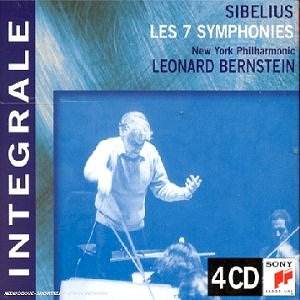Sibelius's symphonic alpha and omega are separated
by only a quarter of a century. What a journey! From the First
Symphony, rooted in Balakirev and Kalinnikov as much as Tchaikovsky,
to the gaunter grandeur in the succinct Seventh Symphony.
Bernstein's 1960s Sibelius carries a good reputation.
It is no surprise then that the bargain reissue of the seven symphonies
in 2000 on French Sony sold well when it found its way outside
France. The set used to be on two mid-price Sony Royal Classics
boxes and before that in a single box.
Bernstein keeps things pressed forward in the
Second Symphony. As one would expect in a work written
in Sibelius's Tchaikovskian-romantic phase the conductor is in
his element. In this he is aided by a recording that brings out
many fine touches that go for nothing in other hands. Try the
stuttering accompanimental string figures at 6.48 in the second
movement. This is a stirring reading - whipped and hoarse. I would
not place it above the Ormandy (also Sony Essential Classics)
but it is an imaginative and fiery piece of recreative work.
Luonnotar goes quite well with
a very fast pulse - faster than I have ever heard it. The strings
sound fine as does the harp. Curtin (regrettably twice shown as
‘Curtis’ in the documentation) gives a pointful performance giving
every sign of wanting to enunciate the delightful Finnish words.
She is an improvement on Ashkenazy's Decca Söderström
whose vibrato seriously damages the piece. Better are Berglund's
Taru Valjakka (in an eight CD EMI Sibelius bargain box) and Panula's
Mari-Anne Häggander (Bis CD270). Curtin's sometimes unmaidenly
tone is not ideal but works well most of the time.
Bernstein's Pohjola's Daughter is
again good - very good in fact - with the usual taut and tightly
articulated string work and well-characterised woodwind. The little
pizzicato rush at 3.39 is an example of Bernstein's freshly sculpted
approach. He occasionally undermines things by rapid tempi that
strike me as thoughtless or done with the aim of display alone.
This version of the tone poem does not displace the early 1970s
Decca recording by the Suisse Romande conducted by Horst Stein
(Weekend Classics). That collection also contains a glorious En
Saga and a black as coal Finlandia.
The recording is apt to Bernstein's impassioned
way with the First Symphony. Listen to the petulance -
almost vituperation - at 4.30 in the first movement of the First
and again at 10.30 in the Seventh. He injects a snappy edginess
to the scherzo. In a world thronged with weaker Sevenths
Bernstein's can be counted among the strong. A notch down from
Mravinsky (BMG-Melodiya, 1965) and Ormandy (also Sony), his sturdy,
compulsively organic interpretation reflects the grandeur with
which Sibelius imbued this outstanding score. These are healthy,
risk-taking Sibelius readings with safety protocols disengaged.
In the First Symphony Bernstein cannot withstand the superb competition
of Barbirolli’s EMI version (only in a boxed set, I am afraid),
Stokowski’s 1976 account (Sony nla but included on EMI’s Stokowski
volume in ‘Great Conductors of the Century’) or Maazel’s Decca
VPO recording. This has nothing to do with exegesis; the issue
is sound quality.
In the Sixth Symphony Bernstein finds
a renewing power. He surprised me with his measured and leisurely
tempo for the first movement's preface. This makes the ensuing
allegro episode, taken at a vitally spirited pace, all
the more telling. This is music making that is hushed, tense,
virile yet poetic; overwhelming qualities in Sibelius. Listen
to the building of the climactic eloquence of the second movement
at 3.18 as well as the scudding abrasion of the opening bars of
the third movement. Only in the finale did I wonder whether things
were becoming prosaic. A more classical idyllic mood-set dominates
the Third Symphony which was recorded two years before
the Sixth. Bernstein makes time for impulsive gestures amid the
subdued lighting of the forest glades. In the finale Bernstein
is amongst the most successful, alongside Kamu on DG, at shaping
a vigorous conclusion which avoids the romantic urge of the first
two symphonies and yet suffuses the classical spirit with a pent-up
rapture. This movement made me think of the finale of Mozart's
Jupiter.
The Fourth and Fifth are on the third CD. As
in the Sixth Bernstein in the Fourth Symphony adopts a
very broad tempo. This is music, inward-looking, brow-furrowed.
The elegantly shaped and oboe-decorated allegro is far broader
and more pointful than the allegro molto vivace marking
would infer. This is an extremely slow performance in which, especially
in the unbearably protracted finale, idiosyncrasy tips over into
eccentricity.
There is no dud among the other works in this
box. The Fifth Symphony is a ‘centre grain’ interpretation
where I wondered whether Bernstein's enthusiasm rather than his
interest was being constantly sustained. Certainly it flares brightly
in the finale. Oddly enough, in the extraordinarily personal reading
of the Fourth, I never once felt that Bernstein's concentration
was drifting out of focus.
The sonics are pretty good throughout without
being in any way resplendent. Fresh as paint really; the only
downside being the print-through pre-echo you get when a silence
precedes a loud brass exclamation as in the second movement of
the First Symphony. Analogue hiss only obtrudes in the whispered
opening measures of the Seventh. Harps and woodwind solos are
given an engineer's helping hand … and very welcome too.
These are stereo recordings but the imperious
lifelike qualities of Decca recordings at their best elude CBS.
We are talking about recordings made between forty and fifty years
ago. They still sounds good enough for this disc to be compared
with Barbirolli, Ashkenazy and Vänskä. Its value is
not yet purely historical.
The coupling scheme is CD1: 1 and 3; CD2: 2,
Luonnotar; Pohjola's Daughter; CD4 4 and 5; CD4:
6 and 7. CD2 mimics the contents of a disc long separately available
in the Bernstein Century series. CD3 is coupled exactly as a disc
in Sony's Bernstein ‘original jackets’ box (soon to be reviewed
here by Jonathan Woolf). CD1 contains a First which had a separate
existence in the Bernstein's ‘Century’ series coupled with the
Seventh.
This is, in general, deft Sibelius. For the most
part Bernstein wrong foots the usual presumptions about swooping
romanticism and inability to distinguish between sentiment and
sentimentality (John L Holmes). Only the Fourth Symphony is mannered
in much the same way as Bernstein's 1980s recording of the Enigma
with the BBC Symphony Orchestra (DG). Then again, late in
his career he recorded with the Vienna Philharmonic a 51 minute
Second Symphony on DG digital 419 172-1GH. This was taken from
a performance in the Grosser Musikvereinsaal, Vienna during October
1986. Insupportable! His 36 minute VPO/DG Fifth Symphony was similarly
distended (DG 427 647-4GH c/w Symphony No. 7). Of that 1980s partial
cycle the reportedly most successful ‘volley’ was Symphony No.
1 435 351-2GH at 41 minutes. Bernstein and DG never completed
the Seven. Symphonies 3, 4 and 6 were left in the realms of the
imagination.
The bargain price of the present set, presumably
circa £20.00, perhaps prepares us for a booklet that has covers
that are just plain blue - no text on the covers. You cannot,
without opening it, tell which way up it is. A nice feature is
that the date of the premiere appears inside the booklet track-listing
underneath the main title of each work. Matthias Henke's notes
are far too preoccupied with telling us what is going on in the
music at a technical level to be much of an adornment.
This compilation is patented to Sony France.
The set was issued there in different livery back in 2001 on 5023162
(see the lower of the two covers above). That set is still available
on Amazon.fr at 21.24 euros as well as at www.zweitausendeins.de
at 19.99 euros. Amazon.uk will sell you that French imported set
for £23.99 (amazon co uk).
This Sony UK issue is a recommendable full cycle. There are compromises
but you would not be done a disservice as a neophyte to learn
your Sibelius from this source.
Rob Barnett


![]() New York PO/Leonard
Bernstein
New York PO/Leonard
Bernstein![]() SONY CLASSICS SM4K87329
[4CDs: 62.40+64.51+71.74+49.15]
SONY CLASSICS SM4K87329
[4CDs: 62.40+64.51+71.74+49.15]